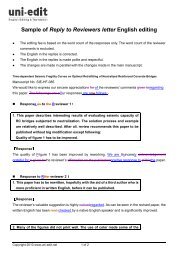Sample Masters Thesis Web design - Uni-edit
Sample Masters Thesis Web design - Uni-edit
Sample Masters Thesis Web design - Uni-edit
Create successful ePaper yourself
Turn your PDF publications into a flip-book with our unique Google optimized e-Paper software.
<strong>Sample</strong> <strong>Masters</strong> <strong>Thesis</strong> Editing<strong>Web</strong> DesignThe visual Visual power of website visual presentationAn investigation of the Aestheticaesthetic/Visual visual preference of websiteuser groupsAbstractTo ensure effective In the field of website communication, the an effective visualpresentation needs to acknowledge the user group’s visualexperienceaesthetic/visual preferences. The experience can be related toaesthetic/visual preference. At present, it is clear that this principle ofcommunication <strong>design</strong> is somewhat neglected and hence in need ofdevelopmentHowever, it is a neglected area of communication <strong>design</strong>.The aim of this research is to examine the aesthetic/visual preference of universitystudents in the disciplines of Communication Design and InformationTechnology in both Australia and Taiwan. Their different cultural backgrounds ofthese students will be compared as a possible influence on any differingapproaches to the visual presentation of websitesin relation to the website visualpresentation will be compared. This investigation adopts Kress and Leeuwen’scoding orientation of visual modality including: scientific/technological coding,sensory coding, abstract coding and naturalistic coding (1996: 107). These codingcategories were applied by Cleveland (2005) in order to ascertainexamine thevisual power of magazine <strong>design</strong>. The present studyresearch classifiesadopts them©2009 征 文 www.uni-<strong>edit</strong>.net Contact: ozy@uni-<strong>edit</strong>.net
into four digital <strong>design</strong> categories as models to test the visual power of websitevisual presentation. A 10-point Likert-scale questionnaire based on these fourclassified digital <strong>design</strong> categories was distributed to gain a better understandingof the aesthetic preferences of university students. The results show that thepower of visual presentation is determined by both Dynamic Impact and AestheticAppeal, and that different aesthetic preferences do exist in different culturalbackgrounds. The findings of this study will contribute to the knowledge of webaesthetics, and serve as a reference for website <strong>design</strong>ers.©2009 征 文 www.uni-<strong>edit</strong>.net Contact: ozy@uni-<strong>edit</strong>.net
professional backgrounds such as different nationality or occupational trainingbackground.? Kress and Leeuwen studied visual modality and categorized visualpresentation into four categories (1996: 107). This research adopts the concept ofthe visual modal category proposed by these two scholars as the basis formeasurement. Following their notion of visual modality, the preferencecharacteristics of user groups from different backgrounds are investigated. Inaddition, their visual judgments or visual experiences may be influenced by themass media or other factors such as educational background (Bourdieu 1987:241). Therefore, the user background has influenced the visual preference of eachuser group. The outcomes would then serve as the practical basis for visual<strong>design</strong>ers and visual <strong>design</strong> presentation in order to improve the quality of futurewebsite communication.Moreover, usability is one of an essential elements ofwhen website <strong>design</strong>s areconcerned. User preference is one of the key considerations in the usability ofwebsite visual presentation. Hence, a website <strong>design</strong>er needs to first clarify thevisual preference of users first in order to improve communication efficiency andenhance the communication quality of messages. Furthermore, identical contentof online instructional materials can be <strong>design</strong>ed into a number of different visualpresentations through the combination of different visual elements. Therefore, theinvestigations of visual communication <strong>design</strong> and a user-centered approach willbe the main foci of this research, and with online instructional materials werechosen serving as a case study.1.1 Outline of thesisThis chapter (Chapter 1) outlines the research topic and relevant issues.©2009 征 文 www.uni-<strong>edit</strong>.net Contact: ozy@uni-<strong>edit</strong>.net
Chapter 2 compares the differences between printing and electronic media;clarifies required <strong>design</strong> elements in the <strong>design</strong> process such as the interactionbetween visual element combinations and a user’s visual preference; investigatesthe relationship between website visual presentation and visual power through aliterature review.Chapter 3 adopts the Kress and Leeuwen’s coding orientation of visual modalityand presents online instructional materials as a case study to investigate the visualpower of visual presentation and the difference of varying visual preferencesamong users with from different cultural backgrounds.Chapter 4 describes the pretest and results. The results show the difference invisual preference among users with different cultural backgrounds. In addition,the website visual power is determined by its Dynamic Impact and AestheticAppeal.Chapter 5 concludes and outlines the direction for further researches. How to Thematter of finding a balance between Dynamic Impact and Aesthetic Appeal isremains a question to be solved by website visual <strong>design</strong>ers.The following chapters will conduct exploratory research on these questions toconstruct visual preference knowledge.©2009 征 文 www.uni-<strong>edit</strong>.net Contact: ozy@uni-<strong>edit</strong>.net
Chapter 2Visual power of website visual presentationIn modern lives, people are exposed to great visual stimuli from the modernmedia (Forlizzi 2002: 3). The Internet has grown to become one of the mainmedia channels. From the perspective of visual presentation, when users accessthe Internet to receive messages, the browser also offers users the greatopportunity to enter into access to a great variety of websites , such as some popmusic websites, where strong visual stimulation is used to attract the attention ofusers. However, base on the ideal of an effective communication, eEach websitehas its own characteristic of visual presentation that endeavors to catch users’attention,. For example, e.g.the visual presentation of a book store’s website mustconcentrate on the online selling of booksvisual presentation has a main goal tosell books online. Thus, according to the various user groups, the formation ofvisual <strong>design</strong> elements in a visual presentation, needs to be pertinent to distinctfrom the user groups’ background, age and gender. Designers are required toanalyze the user groups in order to decide the best use of visual <strong>design</strong> elements.The elements of website visual presentation include the utilization of space, fonts,image and color. The arrangement of these elements determines the value of thevisual <strong>design</strong>. The definition of ‘visual <strong>design</strong>’ according to Resnick (2003: 16),Comment [NP1]: CHECK:age and gender are generallyconsidered part of a person’sbackground. Weresocioeconomic and culturalbackground perhaps the otherfactors to be considered here?is ‘the planned arrangement of visual elements organized and prioritized into acohesive whole that becomes the visual message’. Each element in the visualpresentation is codified to form a strong and powerful visual message. Thisnotion proposes that the formation of visual elements plays a key role in websitevisual presentation, and the research is required to find the linkingelements/relationship between user groups and website visual presentation.©2009 征 文 www.uni-<strong>edit</strong>.net Contact: ozy@uni-<strong>edit</strong>.net







